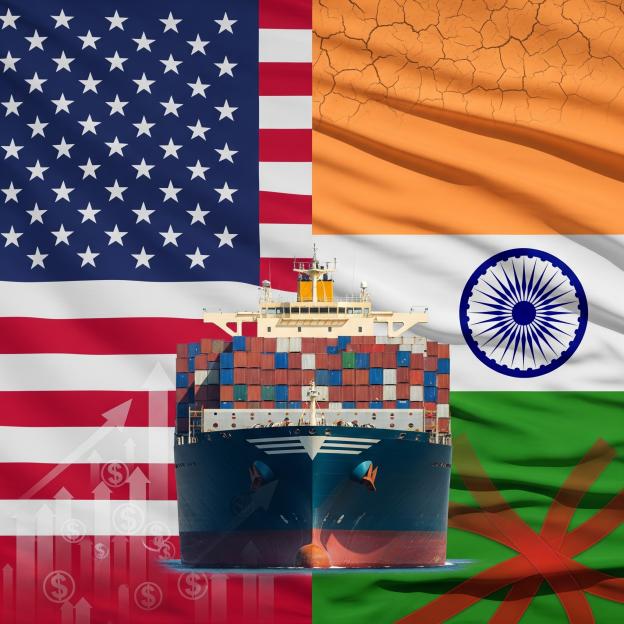The recent announcement of sweeping US tariffs on Indian imports has sent shockwaves through the trade corridors of both nations. Here’s what India needs to know and how the country can respond strategically.
The Tariff Bombshell
On July 30, 2025, US President Donald Trump delivered a significant blow to India-US trade relations by announcing a comprehensive 25% tariff on all Indian imports, effective from August 1, 2025. This dramatic escalation goes beyond the existing steel and aluminum tariffs that have already strained bilateral trade ties.
Trump’s justification for these punitive measures centers on three key grievances: India’s own high tariffs on US goods, what he termed “strenuous and obnoxious non-monetary trade barriers,” and India’s continued energy and military purchases from Russia. The announcement also includes an unspecified “penalty” related to India’s Russia trade, adding another layer of uncertainty to an already complex situation.
India’s Firm Response
India’s Ministry of External Affairs has not minced words in its response, calling the tariffs “unjustified and unreasonable.” The government has pointedly highlighted the hypocrisy in US criticism, noting that both the US and European Union maintain significant trade relationships with Russia themselves. India’s position is clear: its oil imports are guided by national interests and energy security considerations, not external pressure.
The Broader Context
This latest development builds on existing trade tensions. The US had previously imposed a 25% tariff on certain Indian steel products and a 10% tariff on aluminum in March 2018. The situation worsened in June 2025 when these tariffs were doubled to 50% for most countries, though the UK was notably exempted due to its existing trade agreement with the US.
India’s Strategic Options
Despite the challenging circumstances, India has multiple pathways to navigate this crisis:
Diplomatic Engagement
India remains committed to bilateral trade negotiations, continuing to pursue a fair and mutually beneficial trade agreement with the US. This diplomatic approach involves proposing tariff reductions on specific US products, particularly in agriculture and Liquefied Natural Gas (LNG), while seeking reciprocal concessions.
The World Trade Organization (WTO) route, though complicated by the current state of the WTO’s Appellate Body, remains a crucial option for upholding multilateral trading principles. India has already reserved its right to impose retaliatory duties under WTO norms.
Supporting Domestic Industry
The government is actively considering comprehensive support measures for affected exporters, including financial assistance, reduced testing fees for small-scale exporters, and employment-linked programs for specific sectors like marine products. There’s also a strong push for Indian companies to develop and market their own brands, reducing dependence on foreign markets and enhancing global competitiveness.
Economic Diversification
Perhaps most importantly, India is accelerating its trade diversification strategy. The country is actively pursuing Free Trade Agreements (FTAs) with the European Union, Southeast Asian nations, Australia, and the UK. This multi-pronged approach aims to reduce reliance on any single market and create alternative avenues for Indian exports.
The “Make in India” initiative and “Atmanirbhar Bharat” vision are being leveraged to boost domestic production and reduce import dependency, creating a more resilient economic structure that can better withstand external trade shocks.
Long-term Strategic Positioning
India is focusing on building resilient supply chains, investing in advanced manufacturing, and prioritizing skill development. The country is also aligning with global sustainability trends, investing in green technologies to maintain access to environmentally conscious markets.
International forums like the G20, BRICS, and the Shanghai Cooperation Organisation provide platforms for India to advocate for fair trade practices and build coalitions against protectionism.
The Road Ahead
Despite the tariff announcement, both India and the US express continued commitment to bilateral engagement. This suggests that the current crisis, while serious, may serve as a catalyst for more comprehensive trade negotiations rather than a permanent breakdown in relations.
The challenge for India lies in balancing its economic interests with strategic and political objectives. The country must navigate the complexities of the global trade environment while maintaining its sovereignty in energy and defense partnerships.
Conclusion
Trump’s 25% tariff represents a significant challenge, but it also presents an opportunity for India to accelerate its economic diversification and strengthen its position in the global trade ecosystem. By combining diplomatic engagement with domestic economic reforms and international partnership building, India can not only weather this storm but emerge stronger and more resilient.
The key will be maintaining a balanced approach that protects India’s national interests while keeping the door open for constructive engagement with the US. In an increasingly multipolar world, India’s response to this challenge will be closely watched as a test of its economic diplomacy and strategic autonomy.
As this situation continues to evolve, stakeholders across industries should stay informed about developments and prepare for both challenges and opportunities in the changing trade landscape.







